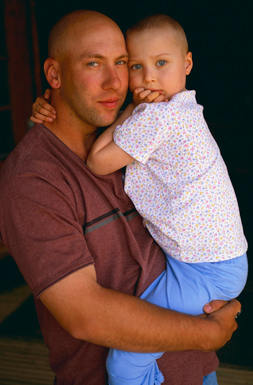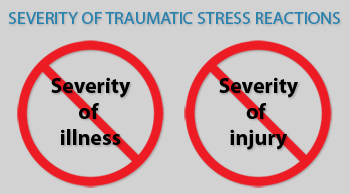Prevalence studies of traumatic stress in ill or injured children

Overall: A meta-analysis of 26 studies of traumatic stress related to pediatric medical events found the following average prevalence rates for significant traumatic stress symptoms:
- Injured children 20%
- Ill children 12% (Kahana, et al. 2006)
Cancer: The prevalence of significant PTSD symptoms in child cancer survivors ranges from 5 - 20%. Higher rates are found among samples of older children, suggesting a developmental trajectory. Persistent PTSD symptoms in child cancer survivors have been associated with other psychosocial concerns in young adulthood. More info
Injuries: The prevalence of PTSD in longer-term studies of children with injuries ranges from 6 - 25%, with larger numbers of children experiencing significant traumatic stress symptoms (sub-syndromal PTSD) and functional impairment. More info
Other conditions: A number of smaller studies suggest the occurrence of longer-term traumatic stress symptoms and PTSD in children facing other conditions and a range of medical treatments, such as intensive care admission, or organ transplantation. More info
Family members: Persistent traumatic stress symptoms have been documented in parents and siblings of childhood cancer survivors, parents of transplant recipients, parents of children with epilepsy, parents of burn patients, and parents of injured children. (See studies by Alderfer, et al. 2003; DeVries et al, 1997; Farley et al, 2007; Hall et al. 2004; Iseri et al., 2006; Manne et al. 2004; Young et al., 2003)
Research evidence about the etiology of medical traumatic stress
Subjective experience vs. objective characteristics
Research evidence consistently indicates that objective characteristics of illness or injury (e.g. severity, complexity) are not strongly related to subsequent traumatic stress symptoms.

Across both injury and illness, evidence suggests that it is the perception of life threat, and the subjective appraisal of severity of injury / illness and intensity of treatment that lead to greater traumatic stress reactions.
However, there is some evidence that the severity or intensity of procedures during intensive care, or the scarring or disfigurement associated with some injuries, can be associated with more severe traumatic stress reactions.
Research to date has identified a range of other risk and protective factors associated with the development of persistent traumatic stress.
Risk factors for traumatic stress in ill or injured children
Pre-existing child, parental or family factors
- Pre -existing anxiety and/or other psychological difficulties
- History of trauma exposure or past traumatic stress symptoms
Early physiological and psychological responses
- More severe acute traumatic stress symptoms (emerging within a few hours or days of a medical event)
- Early physiological arousal in injured children (e.g., elevated heart rate in the ED or hospital)
Aspects of the medical condition or resulting treatment experiences
- Length of hospitalization and intensity of treatment in intensive care
- Separation from parents (and separation anxiety) during emergent care or hospital treatment
- Specific upsetting experiences and perceptions during treatment
Maladaptive coping strategies
- Social and emotional withdrawal
- Extreme avoidance of things that are reminders of a traumatic event
Protective factors that may reduce the development of traumatic stress
Social support
- Parent presence and support
- Maintaining, or re-establishing, age-appropriate social activities and friendships
- Availability of family or friends who can listen and understand
Healthy coping
- A range of coping strategies seem to be adaptive - each individual may be a bit different.
(See studies by Bryant et al.2007; Daviss et al. 2000 Meiser-Steadman, et al. 2005; Phipps, Larson et al 2006)
Many of the same risk and protective factors apply to parents of ill and injured children. For example:
- Among parents of children with cancer, the parent’s own anxiety during treatment, fearing that their child would die, and worrying about relapse is related to persistent parental traumatic stress reactions. (Best, Streisand et al. 2001; Kazak & Barakat, 1997)
- Among parents of children in the PICU, the presence and severity of parental acute traumatic stress responses during their child’s ICU admission, the parent’s subjective appraisal of life threat, and the unexpectedness of the admission are all predictive of persistent parental traumatic stress. (Balluffi et al. 2004)



